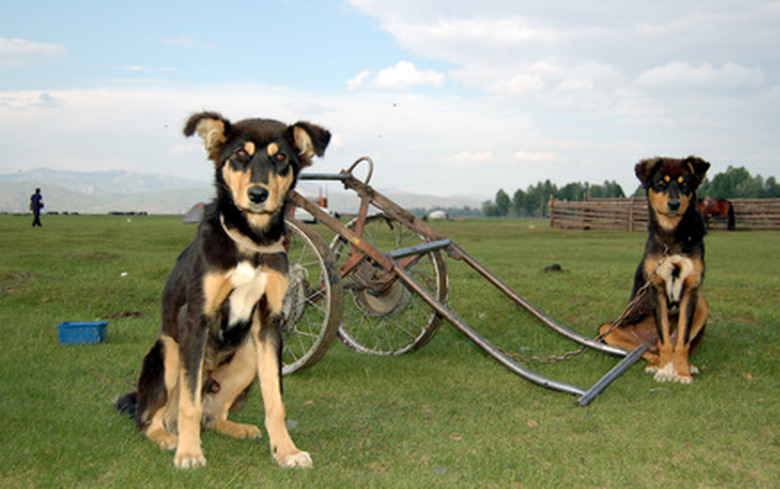How To Build A Dog Pull Cart
Things Needed
-
Cart box or wagon
-
Wheels (two or four of the same size)
-
Axle(s)
-
Two shafts (poles to connect cart box to dog harness)
Warning
Even a trained cart dog can move unexpectedly in any direction, tipping the cart. If the cargo is human, injury could result.
Tip
A wide cart with fat tires is more stable than a dog-width cart with narrow or small wheels. Also, fat tires can take bumpy terrain better than skinny tires. You will need a well-fitted harness that gives the dog's shoulders freedom and distributes the pulling stress across his chest, where he is strongest. Allow the dog to get used to the harness and practice with noisy items such as milk jugs full of water in the cart before you let him pull the cart with a child or other cargo aboard.
A properly balanced dog pull cart allows your dog to haul anything from firewood to people. Sled dogs of the north pull freight across the icy tundra and your dog can haul a cart if properly harnessed. Even toy breeds can pull a cart and a modest load. For a small dog or toy breed, obviously you would build a smaller cart and not expect the little dog to pull a child's weight. The same principles of construction apply to any dog cart. Technically a "cart" is a two-wheeled vehicle, and four wheels make the contraption a "wagon." A dog can pull either, for a total load up to three times his own weight (including the cart).
Step 1
Start with a cart body. Choose either a flatbed platform or an enclosed box, wider than the dog that will pull it. For a large dog such as a Newfoundland, a stable width is 24 inches; 18 inches will work but could be more "tippy." Build the cart body out of lightweight wood, plastic, or even PVC pipe. Or you can use a pre-made garden cart or child's wagon for your cart body. The latter two come with wheels and axles attached.
Step 2
For an un-wheeled cart body, you will need to attach the axle and wheels at the midpoint of the platform or slightly forward, in order for the weight in the cart to be supported by the wheels and axle, not the dog's harness. The dog should not need to lift the weight in the cart as well as pull it; he should have very little weight pressing on his back. Bicycle wheels, wheelchair wheels and pneumatic wheelbarrow tires all make good choices for dog pull-cart wheels.
Step 3
Attach the shafts to the cart body that sit parallel to the ground and parallel to the plane of the cart bed when attached to the dog's harness. The main function of the shaft is for steering the cart. The shafts will attach to the dog's harness at the dog shoulder-height at one end and to the cart bed at the other end. This necessitates creating two bends in the shaft to raise the shaft from cart-bed level to dog-shoulder level. You will find this step easiest if you remove the wheels and set the cart bed on a flat, level surface. Measure from the dog's harness at the shoulder to the ground. Subtract the radius of your wheels and you will have the proper height for the rise of the shafts for this step. (On a wagon, the shafts can be diagonal from the ball-joint of the wagon handle connection to the dog's shoulders, because the wagon's four wheels stabilize the weight.) Make sure you make the shafts long enough to give the dog room to run without the cart touching his back legs. Measure the dog from his chest to the back of his rear leg under his tail. Add to this number over half the distance measured from the shoulder harness to the ground, for kick room.
Step 4
Allow the dog to pull the cart empty before attempting a load, to get him used to the sound and feeling.
